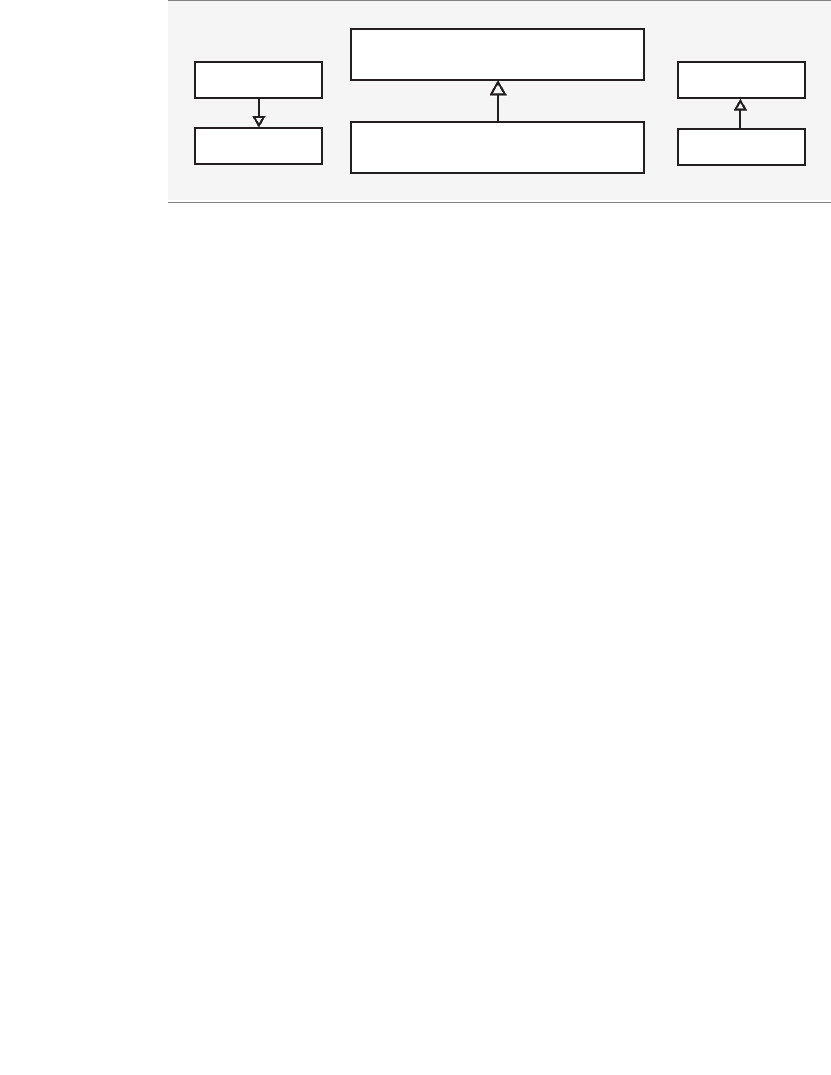Odersky M. Programming in Scala
Подождите немного. Документ загружается.


Section 19.4 Chapter 19 · Type Parameterization 421
Scala tries to be purer than Java in not treating arrays as covariant. Here’s
what you get if you translate the first two lines of the array example to Scala:
scala> val a1 = Array("abc")
a1: Array[java.lang.String] = Array(abc)
scala> val a2: Array[Any] = a1
<console>:5: error: type mismatch;
found : Array[java.lang.String]
required: Array[Any]
val a2: Array[Any] = a1
ˆ
What happened here is that Scala treats arrays as nonvariant (rigid), so an
Array[String] is not considered to conform to an Array[Any]. However,
sometimes it is necessary to interact with legacy methods in Java that use an
Object array as a means to emulate a generic array. For instance, you might
want to call a sort method like the one described previously with an array
of Strings as argument. To make this possible, Scala lets you cast an array
of Ts to an array of any supertype of T:
scala> val a2: Array[Object] =
a1.asInstanceOf[Array[Object]]
a2: Array[java.lang.Object] = Array(abc)
The cast is always legal at compile-time, and it will always succeed at run-
time, because the JVM’s underlying run-time model treats arrays as covari-
ant, just as Java the language does. But you might get ArrayStore excep-
tions afterwards, again just as you would in Java.
19.4 Checking variance annotations
Now that you have seen some examples where variance is unsound, you may
be wondering which kind of class definitions need to be rejected and which
can be accepted. So far, all violations of type soundness involved some re-
assignable field or array element. The purely functional implementation of
queues, on the other hand, looks like a good candidate for covariance. How-
ever, the following example shows that you can “engineer” an unsound situ-
ation even if there is no reassignable field.
Cover · Overview · Contents · Discuss · Suggest · Glossary · Index

Section 19.4 Chapter 19 · Type Parameterization 422
To set up the example, assume that queues as defined in Listing 19.4 are
covariant. Then, create a subclass of queues that specializes the element type
to Int and overrides the append method:
class StrangeIntQueue extends Queue[Int] {
override def append(x: Int) = {
println(Math.sqrt(x))
super.append(x)
}
}
The append method in StrangeIntQueue prints out the square root of its
(integer) argument before doing the append proper. Now, you can write a
counterexample in two lines:
val x: Queue[Any] = new StrangeIntQueue
x.append("abc")
The first of these two lines is valid, because StrangeIntQueue is a subclass
of Queue[Int], and, assuming covariance of queues, Queue[Int] is a sub-
type of Queue[Any]. The second line is valid because you can append a
String to a Queue[Any]. However, taken together these two lines have the
effect of applying a square root method to a string, which makes no sense.
Clearly it’s not just mutable fields that make covariant types unsound.
The problem is more general. It turns out that as soon as a generic parameter
type appears as the type of a method parameter, the containing class or trait
may not be covariant in that type parameter. For queues, the append method
violates this condition:
class Queue[+T] {
def append(x: T) =
...
}
Running a modified queue class like the one above through a Scala compiler
would yield:
Queues.scala:11: error: covariant type T occurs in
contravariant position in type T of value x
def append(x: T) =
ˆ
Cover · Overview · Contents · Discuss · Suggest · Glossary · Index

Section 19.4 Chapter 19 · Type Parameterization 423
Reassignable fields are a special case of the rule that disallows type parame-
ters annotated with + from being used as method parameter types. As men-
tioned in Section 18.2, a reassignable field, “var x: T”, is treated in Scala as
a getter method, “def x: T”, and a setter method, “def x_=(y: T)”. As you
can see, the setter method has a parameter of the field’s type T. So that type
may not be covariant.
The fast track
In the rest of this section, we’ll describe the mechanism by which the
Scala compiler checks variance annotations. If you’re not interested in
such detail right now, you can safely skip to Section 19.5. The most
important thing to understand is that the Scala compiler will check any
variance annotations you place on type parameters. For example, if you try
to declare a type parameter to be covariant (by adding a +), but that could
lead to potential runtime errors, your program won’t compile.
To verify correctness of variance annotations, the Scala compiler classi-
fies all positions in a class or trait body as positive, negative, or neutral. A
“position” is any location in the class (or trait, but from now on we’ll just
write “class”) body where a type parameter may be used. Every method
value parameter is a position, for example, because a method value parame-
ter has a type, and therefore a type parameter could appear in that position.
The compiler checks each use of each of the class’s type parameters. Type
parameters annotated with + may only be used in positive positions, while
type parameters annotated with - may only be used in negative positions.
A type parameter with no variance annotation may be used in any position,
and is, therefore, the only kind of type parameter that can be used in neutral
positions of the class body.
To classify the positions, the compiler starts from the declaration of a
type parameter and then moves inward through deeper nesting levels. Po-
sitions at the top level of the declaring class are classified as positive. By
default, positions at deeper nesting levels are classified the same as that at
enclosing levels, but there are a handful of exceptions where the classifica-
tion changes. Method value parameter positions are classified to the flipped
classification relative to positions outside the method, where the flip of a pos-
itive classification is negative, the flip of a negative classification is positive,
and the flip of a neutral classification is still neutral.
Besides method value parameter positions, the current classification is
also flipped at the type parameters of methods. A classification is sometimes
Cover · Overview · Contents · Discuss · Suggest · Glossary · Index

Section 19.5 Chapter 19 · Type Parameterization 424
flipped at the type argument position of a type, such as the Arg in C[Arg],
depending on the variance of the corresponding type parameter. If C’s type
parameter is annotated with a + then the classification stays the same. If
C’s type parameter is annotated with a -, then the current classification is
flipped. If C’s type parameter has no variance annotation then the current
classification is changed to neutral.
As a somewhat contrived example, consider the following class defini-
tion, where the variance of several positions is annotated with
+
(for positive)
or
−
(for negative):
abstract class Cat[-T, +U] {
def meow[W
−
](volume: T
−
, listener: Cat[U
+
, T
−
]
−
)
: Cat[Cat[U
+
, T
−
]
−
, U
+
]
+
}
The positions of the type parameter, W, and the two value parameters,
volume and listener, are all negative. Looking at the result type of meow,
the position of the first Cat[U, T] argument is negative, because Cat’s first
type parameter, T, is annotated with a -. The type U inside this argument is
again in positive position (two flips), whereas the type T inside that argument
is still in negative position.
You see from this discussion that it’s quite hard to keep track of variance
positions. That’s why it’s a welcome relief that the Scala compiler does this
job for you.
Once the variances are computed, the compiler checks that each type
parameter is only used in positions that are classified appropriately. In this
case, T is only used in negative positions, and U is only used in positive
positions. So class Cat is type correct.
19.5 Lower bounds
Back to the Queue class. You saw that the previous definition of Queue[T]
shown in Listing 19.4 cannot be made covariant in T because T appears as a
type of a parameter of the append method, and that’s a negative position.
Fortunately, there’s a way to get unstuck: you can generalize the append
method by making it polymorphic (i.e., giving the append method itself a
type parameter) and using a lower bound for its type parameter. Listing 19.6
shows a new formulation of Queue that implements this idea.
Cover · Overview · Contents · Discuss · Suggest · Glossary · Index

Section 19.5 Chapter 19 · Type Parameterization 425
class Queue[+T] (private val leading: List[T],
private val trailing: List[T] ) {
def append[U >: T](x: U) =
new Queue[U](leading, x :: trailing) // ...
}
Listing 19.6 · A type parameter with a lower bound.
The new definition gives append a type parameter U, and with the syntax,
“U >: T”, defines T as the lower bound for U. As a result, U is required to be a
supertype of T.
1
The parameter to append is now of type U instead of type T,
and the return value of the method is now Queue[U] instead of Queue[T].
As an example, suppose there is a class Fruit with two subclasses,
Apple and Orange. With the new definition of class Queue, it is possible to
append an Orange to a Queue[Apple]. The result will be a Queue[Fruit].
This revised definition of append is type correct. Intuitively, if T is a
more specific type than expected (for example, Apple instead of Fruit), a
call to append will still work, because U (Fruit) will still be a supertype of
T (Apple).
2
The new definition of append is arguably better than the old one, because
it is more general. Unlike the old version, the new definition allows you to
append an arbitrary supertype U of the queue element type T. The result is
then a Queue[U]. Together with queue covariance, this gives the right kind
of flexibility for modeling queues of different element types in a natural way.
This shows that variance annotations and lower bounds play well to-
gether. They are a good example of type-driven design, where the types of
an interface guide its detailed design and implementation. In the case of
queues, you would probably not have thought of the refined implementation
of append with a lower bound, but you might have decided to make queues
covariant. In that case, the compiler would have pointed out the variance
error for append. Correcting the variance error by adding a lower bound
makes append more general and queues as a whole more usable.
1
Supertype and subtype relationships are reflexive, which means a type is both a super-
type and a subtype of itself. Even though T is a lower bound for U, you could still pass in a T
to append.
2
Technically, what happens is a flip occurs for lower bounds. The type parameter U is in
a negative position (1 flip), while the lower bound (>: T) is in a positive position (2 flips).
Cover · Overview · Contents · Discuss · Suggest · Glossary · Index

Section 19.6 Chapter 19 · Type Parameterization 426
This observation is also the main reason that Scala prefers declaration-
site variance over use-site variance as it is found in Java’s wildcards. With
use-site variance, you are on your own designing a class. It will be the clients
of the class that need to put in the wildcards, and if they get it wrong, some
important instance methods will no longer be applicable. Variance being a
tricky business, users usually get it wrong, and they come away thinking that
wildcards and generics are overly complicated. With definition-side vari-
ance, you express your intent to the compiler, and the compiler will double
check that the methods you want available will indeed be available.
19.6 Contravariance
So far in this chapter, all examples you’ve seen were either covariant or non-
variant. But there are also cases where contravariance is natural. For in-
stance, consider the trait of output channels shown in Listing 19.7:
trait OutputChannel[-T] {
def write(x: T)
}
Listing 19.7 · A contravariant output channel.
Here, OutputChannel is defined to be contravariant in T. So an output chan-
nel of AnyRefs, say, is a subtype of an output channel of Strings. Al-
though it may seem non-intuitive, it actually makes sense. To see why, con-
sider what you can do with an OutputChannel[String]. The only sup-
ported operation is writing a String to it. The same operation can also
be done on an OutputChannel[AnyRef]. So it is safe to substitute an
OutputChannel[AnyRef] for an OutputChannel[String]. By contrast,
it would not be safe to substitute an OutputChannel[String] where an
OutputChannel[AnyRef] is required. After all, you can send any object
to an OutputChannel[AnyRef], whereas an OutputChannel[String] re-
quires that the written values are all strings.
This reasoning points to a general principle in type system design: it
is safe to assume that a type T is a subtype of a type U if you can sub-
stitute a value of type T wherever a value of type U is required. This is
called the Liskov Substitution Principle. The principle holds if T supports the
same operations as U and all of T’s operations require less and provide more
Cover · Overview · Contents · Discuss · Suggest · Glossary · Index

Section 19.6 Chapter 19 · Type Parameterization 427
trait Function1[-S, +T] {
def apply(x: S): T
}
Listing 19.8 · Covariance and contravariance of Function1s.
than the corresponding operations in U. In the case of output channels, an
OutputChannel[AnyRef] can be a subtype of an OutputChannel[String]
because the two support the same write operation, and this operation re-
quires less in OutputChannel[AnyRef] than in OutputChannel[String].
“Less” means the argument is only required to be an AnyRef in the first case,
whereas it is required to be a String in the second case.
Sometimes covariance and contravariance are mixed in the same type.
A prominent example is Scala’s function traits. For instance, whenever you
write the function type A => B, Scala expands this to Function1[A, B]. The
definition of Function1 in the standard library uses both covariance and
contravariance: the Function1 trait is contravariant in the function argument
type S and covariant in the result type T, as shown in Listing 19.8. This
satisfies the Liskov substitution principle, because arguments are something
that’s required, whereas results are something that’s provided.
As an example, consider the application shown in Listing 19.9. In this
example, class Publication contains one parametric field, title, of type
String. Class Book extends Publication and forwards its string title
parameter to the constructor of its superclass. The Library singleton object
defines a set of books and a method printBookList, which takes a function,
named info, of type Book => AnyRef. In other words, the type of the lone
parameter to printBookList is a function that takes one Book argument and
returns an AnyRef. The Customer application defines a method, getTitle,
which takes a Publication as its lone parameter and returns a String, the
title of the passed Publication.
Now take a look at the last line in Customer. This line invokes Library’s
printBookList method and passes getTitle, wrapped in a function value:
Library.printBookList(getTitle)
This line of code type checks even though String, the function’s result type,
is a subtype of AnyRef, the result type of printBookList’s info param-
eter. This code passes the compiler because function result types are de-
Cover · Overview · Contents · Discuss · Suggest · Glossary · Index

Section 19.6 Chapter 19 · Type Parameterization 428
class Publication(val title: String)
class Book(title: String) extends Publication(title)
object Library {
val books: Set[Book] =
Set(
new Book("Programming in Scala"),
new Book("Walden")
)
def printBookList(info: Book => AnyRef) {
for (book <- books) println(info(book))
}
}
object Customer extends Application {
def getTitle(p: Publication): String = p.title
Library.printBookList(getTitle)
}
Listing 19.9 · Demonstration of function type parameter variance.
clared to be covariant (the +T in Listing 19.8). If you look inside the body of
printBookList, you can get a glimpse of why this makes sense.
The printBookList method iterates through its book list, and invokes
the passed function on each book. It passes the AnyRef result returned by
info to println, which invokes toString on it and prints the result. This
activity will work with String as well as any other subclass of AnyRef,
which is what covariance of function result types means.
Now consider the parameter type of the function being passed to the
printBookList method. Although printBookList’s parameter type is de-
clared as Book, the getTitle we’re passing in takes a Publication, a su-
pertype of Book. The reason this works is that since printBookList’s pa-
rameter type is Book, the body of the printBookList method will only be
allowed to pass a Book into the function. And because getTitle’s parameter
type is Publication, the body of that function will only be able to access on
its parameter, p, members that are declared in class Publication. Because
any method declared in Publication is also available on its subclass Book,
everything should work, which is what contravariance of function parameter
Cover · Overview · Contents · Discuss · Suggest · Glossary · Index

Section 19.7 Chapter 19 · Type Parameterization 429
Publication => String
Book => AnyRef
AnyRef
String
Book
Publication
argument type result type
Figure 19.1 · Covariance and contravariance in function type parameters.
types means. You can see all this graphically in Figure 19.1.
The code in Listing 19.9 compiles because Publication => String is
a subtype of Book => AnyRef, as shown in the center of the Figure 19.1. Be-
cause the result type of a Function1 is defined as covariant, the inheritance
relationship of the two result types, shown at the right of the diagram, is in
the same direction as that of the two functions shown in the center. By con-
trast, because the parameter type of a Function1 is defined as contravariant,
the inheritance relationship of the two parameter types, shown at the left of
the diagram, is in the opposite direction as that of the two functions.
19.7 Object private data
The Queue class seen so far has a problem in that the mirror operation might
repeatedly copy the trailing into the leading list if head is called several
times in a row on a list where leading is empty. The wasteful copying could
be avoided by adding some judicious side effects. Listing 19.10 presents a
new implementation of Queue, which performs at most one trailing to
leading adjustment for any sequence of head operations.
What’s different with respect to the previous version is that now leading
and trailing are reassignable variables, and mirror performs the reverse
copy from trailing to leading as a side-effect on the current queue instead
of returning a new queue. This side-effect is purely internal to the imple-
mentation of the Queue operation; since leading and trailing are private
variables, the effect is not visible to clients of Queue. So by the terminology
established in Chapter 18, the new version of Queue still defines purely func-
tional objects, in spite of the fact that they now contain reassignable fields.
You might wonder whether this code passes the Scala type checker. After
Cover · Overview · Contents · Discuss · Suggest · Glossary · Index

Section 19.7 Chapter 19 · Type Parameterization 430
class Queue[+T] private (
private[this] var leading: List[T],
private[this] var trailing: List[T]
) {
private def mirror() =
if (leading.isEmpty) {
while (!trailing.isEmpty) {
leading = trailing.head :: leading
trailing = trailing.tail
}
}
def head: T = {
mirror()
leading.head
}
def tail: Queue[T] = {
mirror()
new Queue(leading.tail, trailing)
}
def append[U >: T](x: U) =
new Queue[U](leading, x :: trailing)
}
Listing 19.10 · An optimized functional queue.
all, queues now contain two reassignable fields of the covariant parameter
type T. Is this not a violation of the variance rules? It would be indeed,
except for the detail that leading and trailing have a private[this]
modifier and are thus declared to be object private.
As mentioned in Section 13.4, object private members can be accessed
only from within the object in which they are defined. It turns out that ac-
cesses to variables from the same object in which they are defined do not
cause problems with variance. The intuitive explanation is that, in order to
construct a case where variance would lead to type errors, you need to have a
reference to a containing object that has a statically weaker type than the type
the object was defined with. For accesses to object private values, however,
Cover · Overview · Contents · Discuss · Suggest · Glossary · Index
